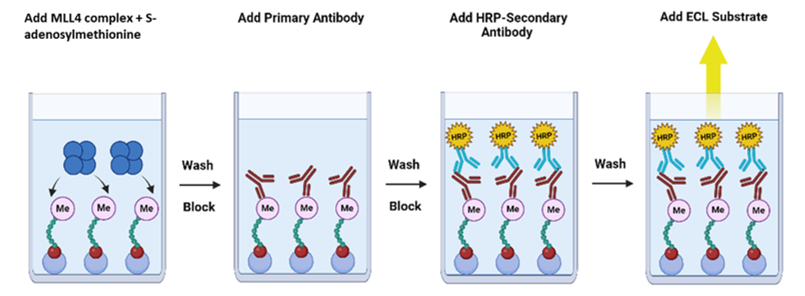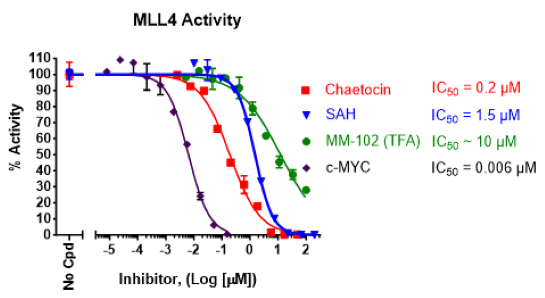MLL4 Complex Chemiluminescent Assay Kit
The MLL4 (KMT2B) Complex Chemiluminescent Assay Kit is designed to measure MLL4 (mixed lineage leukemia protein-4, also known as KMT2B) /WARD complex activity for screening and profiling applications. The MLL4/ WARD complex contains MLL4, WDR5 (WD40 repeat-containing protein 5), Ash2L (Absent, small, homeotic disks-2-like), RbBP5 (retinoblastoma-binding protein 5) and DPY30 (DumPY protein 30). The MLL4 (KMT2B) Complex Chemiluminescent Assay Kit comes in a convenient format, with 8-well strips pre-coated with histone H3 peptide substrate, primary antibody, a secondary HRP-labeled antibody, S-adenosylmethionine, methyltransferase assay buffer, and enough purified MLL4/WARD complex for 100 enzyme reactions.

Figure 1: Illustration of the assay principle.
First, the MLL4 enzyme complex and S-adenosylmethionine are added to pre-coated with histone H3 peptide substrate plate and incubated with or without a test compound. Next, the primary antibody is added. Finally, an HRP-labeled secondary antibody is added, followed by the addition of the HRP substrate to produce chemiluminescence that can be measured using a chemiluminescence reader. Chemiluminescence signal is proportional to the enzymatic activity of the MLL4/WARD complex.
Need us to run inhibitor screens or profile your compounds against MLL4 Complex? Check out our Methyltransferase Screening Services.
- TBST Buffer (1 x TBS, pH 8.0, containing 0.05% Tween-20)
- Microplate reader capable of reading chemiluminescence
- Adjustable micropipettor and sterile tips
- Rotating or rocker platform
| Catalog # | Name | Amount | Storage |
| 100324 | MLL4/WDR5/Ash2L/ RbBP5/DPY30 -WARD Complex (His-Tagged)* | 5 µg | -80°C |
| 52120 | 20 µM S-adenosylmethionine | 2 x 250 µl | -80°C |
| 52140Z | Primary Antibody 26 | 10 µl | -80°C |
| 52160 | 4x HMT Assay Buffer 1 | 3 ml | -20°C |
| 52131H | Secondary HRP-Labeled Antibody 2 | 10 µl | -80°C |
| 52100 | Blocking Buffer 4 | 50 ml | +4°C |
| 79670 | ELISA ECL Substrate A (translucent bottle) | 6 ml | Room Temp |
| ELISA ECL Substrate B (brown bottle) | 6 ml | Room Temp | |
| 0.5 M DTT | 200 µl | -20°C | |
| 96-well plate pre-coated with histone substrate | 1 plate | +4°C |
* The concentration of protein is lot-specific and will be indicated on the tube containing the protein.
The MLL4 (Mixed Lineage Leukemia-4) protein, also known as KMT2B, belongs to the SET1/MLL family which consists of six (MLL1-4/KMT2A-2D, SET1A/KMT2F, and SET1B/KMT2G) major methyltransferases in mammals. MLL4 is a histone-H3 lysine-4 (H3K4) methyltransferase that promotes H3K4 mono-/di-/tri-methylation, a conserved trait of euchromatin associated with transcriptional activation. MLL4 is a critical player for memory formation. MLL4 forms a complex with RbBP5 (retinoblastoma-binding protein 5), ASH2L (Absent, small, homeotic disks-2-like), WDR5 (WD40 repeat-containing protein 5), and DPY30 (DumPY protein 30) to catalyze methylation of H3K4. WDR5 has two protein interaction sites: the WDR5-interacting (WIN) binding site and the WDR5-binding-motif (WBM) site. MLL4 forms the complex via the WIN binding site, while RbBP5 is bound to the WBM site, which is also the site for MYC oncoproteins interaction. WDR5 represents a therapeutically exploitable target for cancer inhibition as it plays a crucial role in MLL4 complex assembly and disassembly. The addition of inhibitors that competitively bind to WIN or WBM sites has been shown to disrupt MLL activity as well as to displace MYC from chromatin and therefore disabling its tumorigenic function.
Wang L., et al., 2021 Biochem Soc Trans 49(6):1041-1054.


